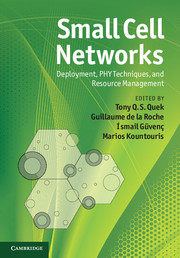Book contents
- Frontmatter
- Contents
- List of contributors
- Foreword by David Chambers
- Acknowledgments
- Acronyms
- 1 Small cell networks overview
- 2 Fundamentals of access control in femtocells
- 3 Coverage analysis using the Poisson point process model
- 4 Interference modeling for cognitive femtocells
- 5 Multiple antenna techniques in small cell networks
- 6 Physical layer techniques for cognitive femtocells
- 7 Femtocell coverage optimization
- 8 Random matrix methods for cooperation in small cell networks
- 9 Mobility in small cell networks
- 10 Cognitive radio resource management in autonomous femtocell networks
- 11 Decentralized reinforcement learning techniques for interference management in heterogeneous networks
- 12 Resource allocation optimization in heterogeneous wireless networks
- 13 New strategies for femto-macro cellular interference control
- 14 Femtocell interference control in standardization
- 15 Spectrum assignment and fairness in femtocell networks
- 16 Self-organization and interference avoidance for LTE femtocells
- Index
- References
4 - Interference modeling for cognitive femtocells
Published online by Cambridge University Press: 05 May 2013
- Frontmatter
- Contents
- List of contributors
- Foreword by David Chambers
- Acknowledgments
- Acronyms
- 1 Small cell networks overview
- 2 Fundamentals of access control in femtocells
- 3 Coverage analysis using the Poisson point process model
- 4 Interference modeling for cognitive femtocells
- 5 Multiple antenna techniques in small cell networks
- 6 Physical layer techniques for cognitive femtocells
- 7 Femtocell coverage optimization
- 8 Random matrix methods for cooperation in small cell networks
- 9 Mobility in small cell networks
- 10 Cognitive radio resource management in autonomous femtocell networks
- 11 Decentralized reinforcement learning techniques for interference management in heterogeneous networks
- 12 Resource allocation optimization in heterogeneous wireless networks
- 13 New strategies for femto-macro cellular interference control
- 14 Femtocell interference control in standardization
- 15 Spectrum assignment and fairness in femtocell networks
- 16 Self-organization and interference avoidance for LTE femtocells
- Index
- References
Summary
Introduction
The possibility of increasing coverage and capacity of radio cellular systems by deploying femtocell base stations is strongly dependent on the capability of avoiding interference with the macrocell network (macrocell users and macrocell base stations). A centralized radio resource allocation procedure controlling the spectrum allocation of the multi-tier network would ensure a perfect coexistence between the macrocell and the femtocell networks. However, such a centralized system is of very high complexity. Considering the distributed nature of the femtocell network, with femtocell base stations placed without planning, a distributed resource allocation system is therefore desirable. In the broader field of cognitive radio networks, frequency band sharing can be based on different approaches. For less dynamic systems, access to the spectrum can be based on the information provided by a central database where geographical information on the spectrum usage is stored. In this case, the cognitive device is aware of its geographical position and can decide which frequency bands can be used to establish a communication link. For the case of femtocells, since the spectrum usage from the macrocell system is quite dynamic and changes frequently, a spectrum allocation relying on database information is not feasible. As for distributed secondary networks, cognitive radio resource management (CRRM) is a solution for a femtocell user (FU) to detect and access the idle spectrum [1-4]. A way to implement the CRRM is to activate a dedicated signaling channel between the macrocell and femtocell networks. The busy channel assessment can be based on the detection of a preamble shared between the macrocell and femtocell networks.
Information
- Type
- Chapter
- Information
- Small Cell NetworksDeployment, PHY Techniques, and Resource Management, pp. 82 - 95Publisher: Cambridge University PressPrint publication year: 2013
